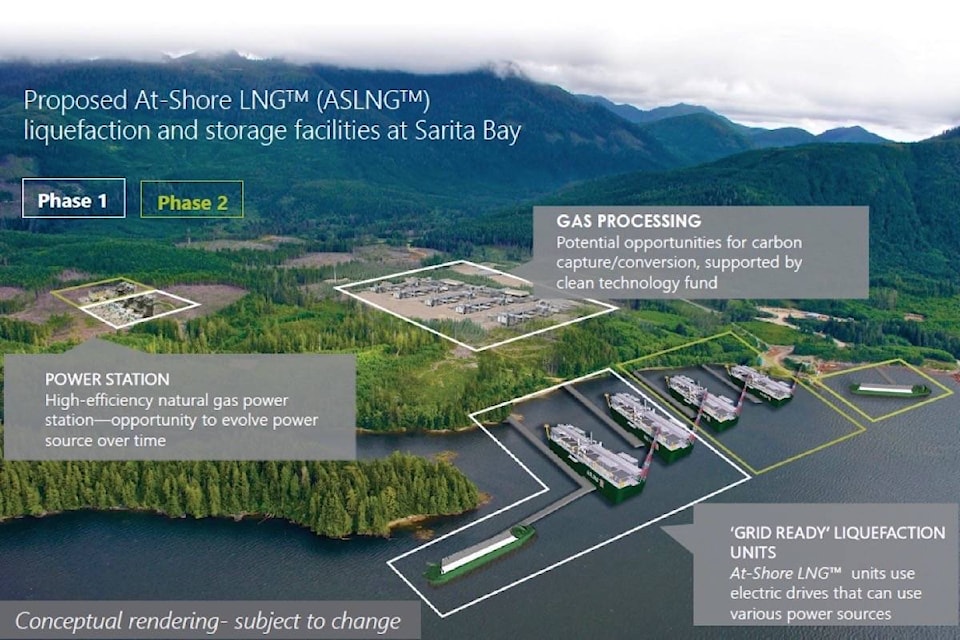Highlights from the proposed Kwispaa LNG project in Barkley Sound:
Co-managers of the Kwispaa LNG project, Steelhead LNG and Huu-ay-aht First Nations (HFN), held information sessions in Ucluelet, Port Alberni, and Bamfield on June 26, 27, and 28 to share updates on a multibillion-dollar industrial development in Barkley Sound.
The proposed liquefied natural gas (LNG) export facility is in the preliminary stages of its environmental assessment and engineering design. Onshore and pipeline project manager Nathan Gloag said a high-level overview of the components planned for the project will be available for public review later this July.
“The Kwispaa LNG Project expects to submit a Project Description to the British Columbia Environmental Assessment Office and Canadian Environmental Assessment Agency this summer, which initiates a multi-year environmental assessment process,” a spokesperson at Steelhead LNG wrote in an email to Black Press Media.
What is LNG?
Liquefied natural gas is natural gas in liquid form.
When cooled to -162 C, the gas turns into liquid, which reduces the volume by approximately 600 times.
Once compressed, the non-renewable fuel source can be loaded onto shipping vessels and transported overseas for sale into international markets. LNG is considered the world’s cleanest burning fossil fuel. It is used for a variety of purposes, such as heating homes, cooking, and generating electricity—visit lngfacts.org for more.
Why Sarita Bay?
Located on Huu-ay-aht owned land, Sarita Bay sits about 10 kilometres north of Bamfield and 11 nautical miles from the open ocean.
The site was selected for a number of reasons, including its short shipping distance to open sea, deep water, flat topography, and natural protection of the bay.
Vancouver-based Steelhead LNG was also looking for an existing industrial area when they landed on Sarita Bay. According to HFC council member Trevor Cootes, Sarita Bay’s ocean zone is benign due to years of industrial logging.
“The bottom is full of bark,” said Cootes at the information session in Port Alberni on June 27. “The areas that [Steelhead] are looking to place the facility, [the salmon] hasn’t been running there for a longtime because of the impacts of forestry.”
Pipeline Routing
A pipeline project is being proposed in tandem with the Kwispaa LNG facility. The potential route would take the natural gas from Northern B.C., south to the Williams Lake area and towards the Powell River river, underneath the Salish Sea to the Courtenay/Comox area, terminating at Sarita Bay.
Huu-ay-aht has been conducting Nation to Nation conversations to build the 1,000-km long stretch of pipeline.
“The idea is we want to form a relationship first before we have the conversation, ‘Hey, we want to lay some pipeline through our territory.’ We thought there would be no better way than Huu-ay-aht themselves and we call it like a cultural protocol,” said Cootes, adding the discussion is being received well.
“The idea of building relationships is not to do it in a way of a business relationship, but to do it in a way of recognizing that it’s First Nations to First Nations.”
READ: Potential route examined for pipeline feeding major West Coast LNG facility (AV NEWS, Mar. 3, 2018)
Floating LNG Terminals
Preliminary designs for the export facility at Sarita Bay involve a “cost competitive” floating structure that would be permanently moored to a marine jetty, according to Gloag.
The floating structures would be double-hulled, like the LNG shipping vessels. He said a site-specific seismic study will probably get underway this fall.
“Most LNG facilities by their nature are on the Coast and located in a tsunami zone. The [Kwispaa] LNG facility with its design life of about 25 years, has to be able to withstand those events,” said Gloag.
How safe is LNG?
While Steelhead LNG said there has been no significant loss of the contaminant at sea or in port in more than 50 years of shipping, award-winning Canadian journalist Andrew Nikiforuk outlined a mixed safety record for LNG Terminals in 2017.
“In fact, a recent and nasty explosion at an LNG facility in Washington State, combined with alarming British research on what scientists call ‘vapour cloud explosions’ or the release of flammable gases into the atmosphere, has raised new doubts about the adequacy of safety regulations for siting LNG export terminals in North America,” Nikiforuk wrote.
READ: Barkley Sound residents at crossroads over LNG project (Vancouver Island Free Daily, Mar. 1, 2018)
